Cylindrical incense burner or brush pot decorated in underglaze blue with landscape and text.
According to Markus Sesko: a poem by Li Bai admiring the beautiful scenery at Mt. Emei. Dimensions: Diameter: 11.5 cm; Height: 10 cm.-
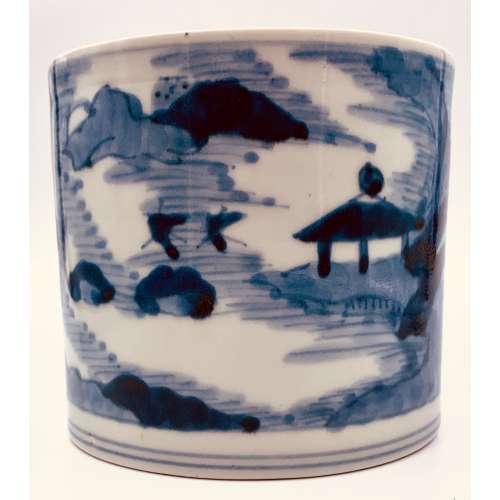
-
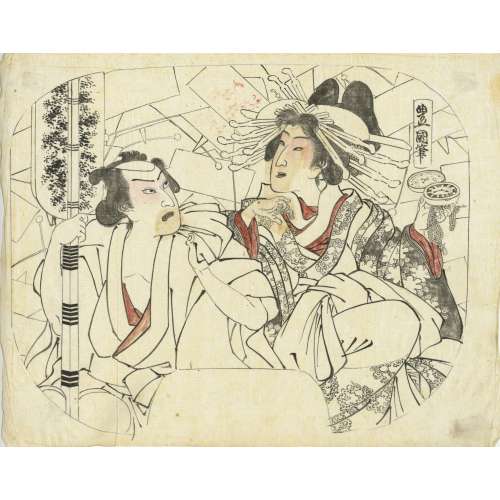 Artist: Horst Graebner positively attributes the drawing to Utagawa Kunisada II [歌川国貞] Japanese, 1823 – 1880) a.k.a. Toyokuni IV, though Israel Goldman attributes it to Utagawa Kunisada [歌川 国貞] (Japanese, 1786 – 1865) a.k.a. Utagawa Toyokuni III. Title: Geisha with a watch / Preparatory drawing for a fan print. Media/Technique: Ink and colour on paper. Signed: Toyokuni hitsu [豊国筆].
Artist: Horst Graebner positively attributes the drawing to Utagawa Kunisada II [歌川国貞] Japanese, 1823 – 1880) a.k.a. Toyokuni IV, though Israel Goldman attributes it to Utagawa Kunisada [歌川 国貞] (Japanese, 1786 – 1865) a.k.a. Utagawa Toyokuni III. Title: Geisha with a watch / Preparatory drawing for a fan print. Media/Technique: Ink and colour on paper. Signed: Toyokuni hitsu [豊国筆]. -
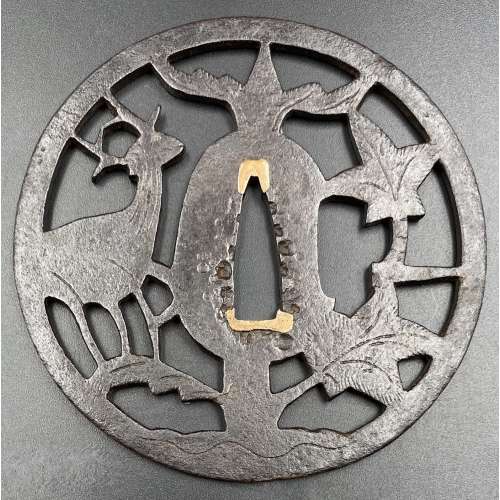
Iron tsuba of round form decorated with a deer and maple leaves in positive silhouette openwork (ji-sukashi), with details finely carved in low relief (kebori). Nakagō-ana plugged with copper fittings (sekigane). Traces of lacquer on the surface.
NBTHK: Hozon, №424947.
Design: An autumnal tsuba with an allusion to Kasuga Shrine in Nara.
Attributed by NBTHK to Shoami. Age: Probably the Momoyama period (1574 – 1603) or early Edo period (1603 – 1650), but judging on the item's substantial size (diameter 86.6 mm) and considerable thinness (3.4 mm) may be attributed to earlier times (late Muromachi period, 1514 – 1573). -
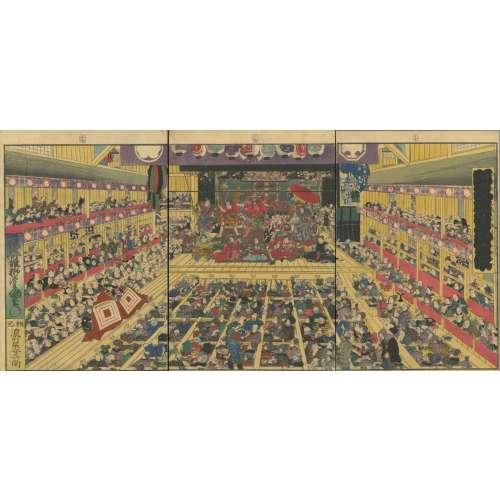 Superb Edo pictures illustrating dances (Odori keiyô Edo-e no sakae): Interior of an imaginary theater with a performance of Shibaraku 「踊形容江戸絵栄」. Artist: Utagawa Kunisada [歌川 国貞] a.k.a. Utagawa Toyokuni III [三代歌川豊国] (Japanese, 1786 – 1865). Publisher: Nōshūya Yasubei (Japanese, fl. c. 1851 – 1870). Year: 1858 (Ansei 5), 7th month. Size: Vertical ôban triptych; 36.9 x 75.7 cm. Signed: 一陽斎雛獅豊国筆(年玉印) – Ichiyôsai Hinashi Toyokuni ga (on left sheet only). Censor's seal: Horse 7 [午七 彫師]. Subject: Shibaraku. Ref.: MFA impression: 11.44263a-c; Robert Schaap. Kunisada (2016), p. 101 [LIB-1212.2017]. Ref.: [LIB-1197.2016] Arendie and Henk Herwig. Heroes of the kabuki stage: an introduction to kabuki with retellings of famous plays, illustrated by woodblock prints. — Amsterdam: Hotei Publishing, 2004; p. 38.
Superb Edo pictures illustrating dances (Odori keiyô Edo-e no sakae): Interior of an imaginary theater with a performance of Shibaraku 「踊形容江戸絵栄」. Artist: Utagawa Kunisada [歌川 国貞] a.k.a. Utagawa Toyokuni III [三代歌川豊国] (Japanese, 1786 – 1865). Publisher: Nōshūya Yasubei (Japanese, fl. c. 1851 – 1870). Year: 1858 (Ansei 5), 7th month. Size: Vertical ôban triptych; 36.9 x 75.7 cm. Signed: 一陽斎雛獅豊国筆(年玉印) – Ichiyôsai Hinashi Toyokuni ga (on left sheet only). Censor's seal: Horse 7 [午七 彫師]. Subject: Shibaraku. Ref.: MFA impression: 11.44263a-c; Robert Schaap. Kunisada (2016), p. 101 [LIB-1212.2017]. Ref.: [LIB-1197.2016] Arendie and Henk Herwig. Heroes of the kabuki stage: an introduction to kabuki with retellings of famous plays, illustrated by woodblock prints. — Amsterdam: Hotei Publishing, 2004; p. 38.
-
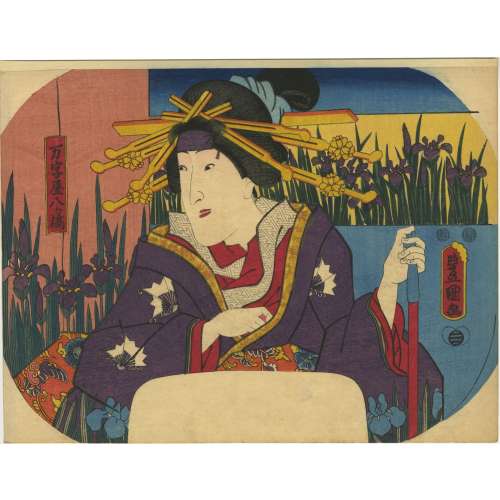 Artist: Utagawa Kunisada [歌川 国貞]; a.k.a. Utagawa Toyokuni III [三代歌川豊国] (Japanese, 1786 – 1865). Signed: Toyokuni ga [豊国 画] in a red toshidama cartouche. Publisher: Ibaya Senzaburō [伊場屋仙三郎] (Japanese, fl. C. 1845 – 1847), seal: San [三] (Marks 11-001 | 127c). Block carver: Matsushima Fusajirō [松嶋房次郎] (Japanese, fl. 1843 – 1850); seal [彫工房] – Hori kō Fusa (Gordon Friese № 134). Double nanushi censor seal: Kunigasa & Watanabe (1849-50). Actor: Iwai Hanshirō VIII [岩井半四郎] (Japanese, 1829 – 1882); other names: Iwai Shijaku II, Iwai Kumesaburō III [岩井粂三郎], Iwai Hisajirō II. Play: Yukari no Hana Iro mo Yoshiwara [紫花色吉原], performed at the Kawarazaki Theater (Edo) from the 5th day of the 5th lunar month of Kaei 3 (1850) (see Kabuki Playbill at MFA (Boston) № 11.27996).
Artist: Utagawa Kunisada [歌川 国貞]; a.k.a. Utagawa Toyokuni III [三代歌川豊国] (Japanese, 1786 – 1865). Signed: Toyokuni ga [豊国 画] in a red toshidama cartouche. Publisher: Ibaya Senzaburō [伊場屋仙三郎] (Japanese, fl. C. 1845 – 1847), seal: San [三] (Marks 11-001 | 127c). Block carver: Matsushima Fusajirō [松嶋房次郎] (Japanese, fl. 1843 – 1850); seal [彫工房] – Hori kō Fusa (Gordon Friese № 134). Double nanushi censor seal: Kunigasa & Watanabe (1849-50). Actor: Iwai Hanshirō VIII [岩井半四郎] (Japanese, 1829 – 1882); other names: Iwai Shijaku II, Iwai Kumesaburō III [岩井粂三郎], Iwai Hisajirō II. Play: Yukari no Hana Iro mo Yoshiwara [紫花色吉原], performed at the Kawarazaki Theater (Edo) from the 5th day of the 5th lunar month of Kaei 3 (1850) (see Kabuki Playbill at MFA (Boston) № 11.27996). A famous Yoshiwara courtesan named Manjiya Yatsuhashi [万字屋 八ツ橋] was killed by a provincial commoner Sano Jirōzaemon [佐野次郎左衛門] (on the second sheet of the pair):
A famous Yoshiwara courtesan named Manjiya Yatsuhashi [万字屋 八ツ橋] was killed by a provincial commoner Sano Jirōzaemon [佐野次郎左衛門] (on the second sheet of the pair):
Another Kunisada's print with the same characters in the same play and same performance can be seen at MFA (Boston) № 11.40190.
SVJP-0298.2019: Ichikawa Ebizō V as Sano Jirōzaemon.

SVJP-0297.2019: Iwai Kumesaburō III as Manjiya Yatsuhashi
 One more example can be seen in the two upper images at Waseda University Cultural Resources Database, № 006-2707:
One more example can be seen in the two upper images at Waseda University Cultural Resources Database, № 006-2707:

-
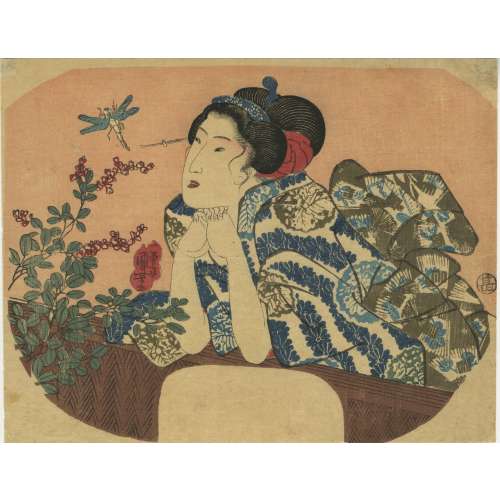 Artist: Utagawa Kuniyoshi [歌川 國芳] (1798 – 1861). A beauty leaning on a fence and watching a dragonfly hovering above a flowering plant. Signed: Ichiyûsai Kuniyoshi ga (一勇斎 國芳 画) in a double gourd-shaped red cartouche. Publisher: Maruya Jinpachi, seal Jin [甚] (Marks 08-088 | 294d). No date/censor seal. Media: Fan print (uchiwa-e, 団扇絵), 234 x 301 mm.
Artist: Utagawa Kuniyoshi [歌川 國芳] (1798 – 1861). A beauty leaning on a fence and watching a dragonfly hovering above a flowering plant. Signed: Ichiyûsai Kuniyoshi ga (一勇斎 國芳 画) in a double gourd-shaped red cartouche. Publisher: Maruya Jinpachi, seal Jin [甚] (Marks 08-088 | 294d). No date/censor seal. Media: Fan print (uchiwa-e, 団扇絵), 234 x 301 mm. -
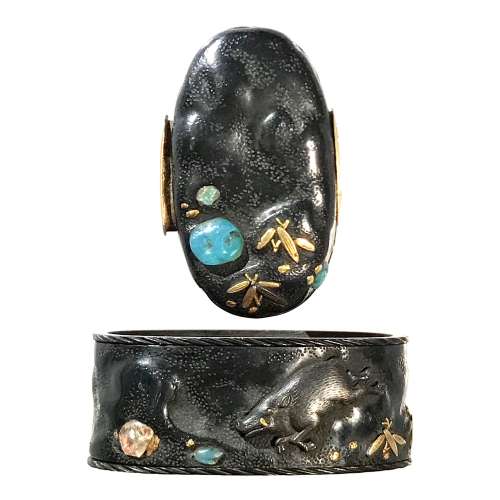 Signature: Unsigned
Signature: UnsignedFuchi-kashira with rock and boar (iwa ni inoshishi zu) motif. Inlay of precious stones or colour glass. Shakudō, gold, gemstones. Technique: Sukibori zogan kiniroe.
Fuchi: 36 x 21 x 14 mm; Weight: 22 g; Kashira: 32 x 17 x 5 mm; Weight: 8 g; Material : Shakudō; Gold; Gemstones (Chalcedony and Rose Quartz). Possibly, Owari school. -
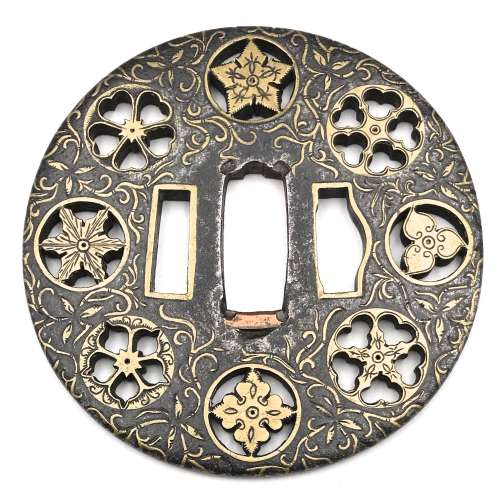 Iron tsuba of round form decorated with eight roundels – circular emblems of flowers and/or family crests (mon) made of cast brass, pierced and chiseled in kebori, and with flat brass inlay (hira-zōgan) of vines or leaves all over the plate. Both hitsu-ana trimmed in brass. Nakago-ana of rectangular form, with copper sekigane. Four positive openwork (ji-sukashi) roundels at 12, 3, 6, and 9 o'clock; and four negative openwork (in-sukashi) roundels with cherry blossom, bellflower, and two variations on suhama theme. Yoshirō school (Kaga-Yoshirō). The Momoyama or early Edo period, late 16th to early 17th century. Size: diameter 81.4 mm, thickness 4.7 mmat seppa-dai, 4.0 mm at rim. Christie's lot description: AN IRON TSUBA; EDO PERIOD (17TH CENTURY). THE DOLPHYN COLLECTION OF SAMURAI ART. The round iron tsuba pierced with roundels of various floral motifs interspersed among scrolling foliage, all inlaid with brass. 8.1 cm. high. Provenance: Pabst Collection (no. 338).
Iron tsuba of round form decorated with eight roundels – circular emblems of flowers and/or family crests (mon) made of cast brass, pierced and chiseled in kebori, and with flat brass inlay (hira-zōgan) of vines or leaves all over the plate. Both hitsu-ana trimmed in brass. Nakago-ana of rectangular form, with copper sekigane. Four positive openwork (ji-sukashi) roundels at 12, 3, 6, and 9 o'clock; and four negative openwork (in-sukashi) roundels with cherry blossom, bellflower, and two variations on suhama theme. Yoshirō school (Kaga-Yoshirō). The Momoyama or early Edo period, late 16th to early 17th century. Size: diameter 81.4 mm, thickness 4.7 mmat seppa-dai, 4.0 mm at rim. Christie's lot description: AN IRON TSUBA; EDO PERIOD (17TH CENTURY). THE DOLPHYN COLLECTION OF SAMURAI ART. The round iron tsuba pierced with roundels of various floral motifs interspersed among scrolling foliage, all inlaid with brass. 8.1 cm. high. Provenance: Pabst Collection (no. 338). -
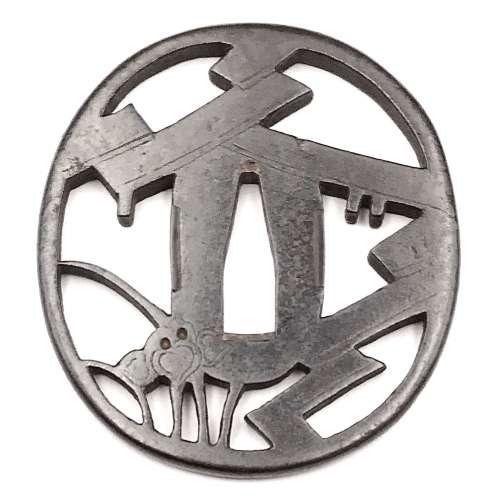 Iron tsuba of oval form with design of iris and plank bridge (yatsubashi) in openwork (sukashi). Rounded cornered rim. Unsigned. Attributed to Jingo - 3rd generation Shimizu, 2nd generation Jingo (1691-1777) [M. Sesko, Genealogy..., p. 94]. Edo period: Late 18th century (Hohreki / Meiwa era). Height: 69.5 mm. Width: 65.2 mm. Rim thickness: 4.6 mm. Center thickness: 4.8 mm. Provenance: Sasano Masayuki Collection, № 251: "Shimizu. Third generation Jingo (died at 87 years of age in the sixth year of An-ei, 1777). The eight-section bridge with irises are arranged to create the design of 'yatsubashi'. The features are unique for the Shimizu school and show no influence of the Hirita, Nishigaki or Hayashi schools". The design visually resembles a butterfly. As described in Family Crests of Japan by Stone Bridge Press [Family Crests of Japan; Stone Bridge Press, Berkeley, CA, 2007], and also in Japanese Family Crests by Yuzuru Okada [Yuzuru Okada. Japanese Family Crests // Series: Tourist Library: 37. Board of tourist industry; Japanese Government Railways, - 1941], there is a special technique used in construction of family crests, called 'reshaping' by the former and 'reconstruction' by the latter: "reconstruction is realized when a motive has its general shape composed of the detail of entirely different motive as, for instance, the crest of a butterfly formed of pine-needles. [...] The fanciful and ingenious forms evolved in this way may be represented by the kasiwa-giri or 'oak-leaf-paulownia', the ogi-bisi or 'fan-lozenge', the matuba-zuru or 'pine-needle-crane', the omodaka-kotyo or 'water-plantain-butterfly', etc." In our case we can call the motif yatsubashi-chocho or 'Iris-and-Bridge—Butterfly'.
Iron tsuba of oval form with design of iris and plank bridge (yatsubashi) in openwork (sukashi). Rounded cornered rim. Unsigned. Attributed to Jingo - 3rd generation Shimizu, 2nd generation Jingo (1691-1777) [M. Sesko, Genealogy..., p. 94]. Edo period: Late 18th century (Hohreki / Meiwa era). Height: 69.5 mm. Width: 65.2 mm. Rim thickness: 4.6 mm. Center thickness: 4.8 mm. Provenance: Sasano Masayuki Collection, № 251: "Shimizu. Third generation Jingo (died at 87 years of age in the sixth year of An-ei, 1777). The eight-section bridge with irises are arranged to create the design of 'yatsubashi'. The features are unique for the Shimizu school and show no influence of the Hirita, Nishigaki or Hayashi schools". The design visually resembles a butterfly. As described in Family Crests of Japan by Stone Bridge Press [Family Crests of Japan; Stone Bridge Press, Berkeley, CA, 2007], and also in Japanese Family Crests by Yuzuru Okada [Yuzuru Okada. Japanese Family Crests // Series: Tourist Library: 37. Board of tourist industry; Japanese Government Railways, - 1941], there is a special technique used in construction of family crests, called 'reshaping' by the former and 'reconstruction' by the latter: "reconstruction is realized when a motive has its general shape composed of the detail of entirely different motive as, for instance, the crest of a butterfly formed of pine-needles. [...] The fanciful and ingenious forms evolved in this way may be represented by the kasiwa-giri or 'oak-leaf-paulownia', the ogi-bisi or 'fan-lozenge', the matuba-zuru or 'pine-needle-crane', the omodaka-kotyo or 'water-plantain-butterfly', etc." In our case we can call the motif yatsubashi-chocho or 'Iris-and-Bridge—Butterfly'. -
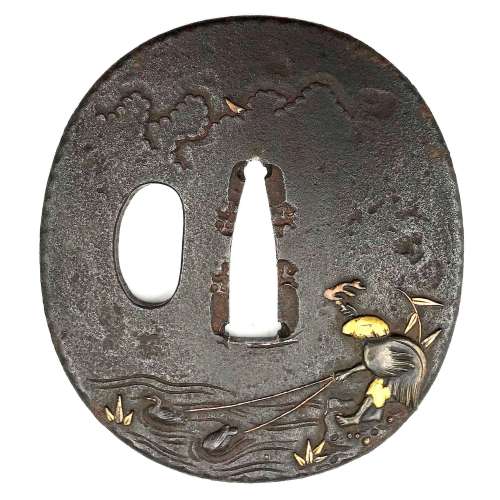 Iron tsuba of oval form carved and inlaid in gold and copper with cormorant fisherman in disguise. Unsigned. Dimensions: 67.7 mm x 61.5 mm x 3.8 mm (at seppa-dai) Edo period: 18th century. "Since Nara period, Japanese fishermen in small boats have used cormorants (u) to catch river fish at night, binding the necks of the birds so that the fish are not swallowed. [...] The bird and the work it performs are symbols of selfless devotion to one's master and keen eyesight." - from Merrily Baird. Symbols of Japan. Thematic motifs in art and design. Rizzoli international publications, Inc., 2001; p. 104. See also TSU-0212 and TSU-0096
Iron tsuba of oval form carved and inlaid in gold and copper with cormorant fisherman in disguise. Unsigned. Dimensions: 67.7 mm x 61.5 mm x 3.8 mm (at seppa-dai) Edo period: 18th century. "Since Nara period, Japanese fishermen in small boats have used cormorants (u) to catch river fish at night, binding the necks of the birds so that the fish are not swallowed. [...] The bird and the work it performs are symbols of selfless devotion to one's master and keen eyesight." - from Merrily Baird. Symbols of Japan. Thematic motifs in art and design. Rizzoli international publications, Inc., 2001; p. 104. See also TSU-0212 and TSU-0096 -
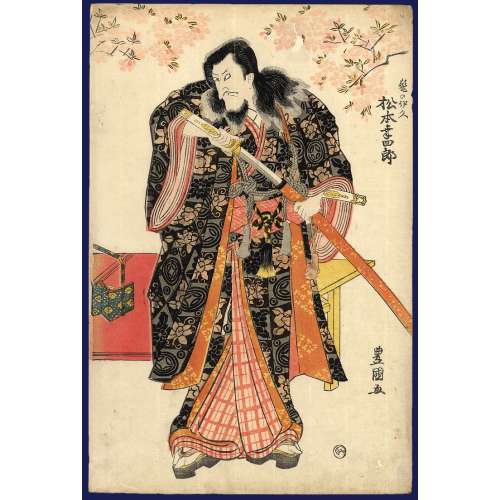 Artist: Utagawa Toyokuni I (1769–1825) Actor Matsumoto Kōshirō V plays the role of Ikyû in the drama "Sukeroku Yukari no Edo Zakura". The roles of Sukeroku and the courtesan Agemaki are played by Ichikawa Danjûrô VII and Iwai Hanshirô V". Ichimura Theater in Edo in 2nd lunar month of 1811. Publisher: Chōjiya Kichi (1811-1826); Marks' "Publishers" № 028, p. 103. Size: Vertical ôban Woodblock print (nishiki-e); ink and color on paper. Signed: Toyokuni ga My print is the right sheet of a triptych (see: Rare books exhibition in January 2013).
Artist: Utagawa Toyokuni I (1769–1825) Actor Matsumoto Kōshirō V plays the role of Ikyû in the drama "Sukeroku Yukari no Edo Zakura". The roles of Sukeroku and the courtesan Agemaki are played by Ichikawa Danjûrô VII and Iwai Hanshirô V". Ichimura Theater in Edo in 2nd lunar month of 1811. Publisher: Chōjiya Kichi (1811-1826); Marks' "Publishers" № 028, p. 103. Size: Vertical ôban Woodblock print (nishiki-e); ink and color on paper. Signed: Toyokuni ga My print is the right sheet of a triptych (see: Rare books exhibition in January 2013). A lookalike triptych by Kunisada can be found in Ronin Gallery:
A lookalike triptych by Kunisada can be found in Ronin Gallery:
 Data from Kabuki21:
Stage names:
Matsumoto Kôshirô V, Ichikawa Komazô III, Ichikawa Sumizô I
Guild: Kôraiya
Line number: GODAIME (V)
Poetry names: Kinshô, Kinkô
Existence: 1764 ~ 10th day of the 5th lunar month of 1838
Connection:
Father: Matsumoto Kôshirô IV
Sons: Matsumoto Kôshirô VI, Ichikawa Sumizô II
Disciples: Matsumoto Kojirô, Matsumoto Kingo I, Matsumoto Hidejûrô II
Data from Kabuki21:
Stage names:
Matsumoto Kôshirô V, Ichikawa Komazô III, Ichikawa Sumizô I
Guild: Kôraiya
Line number: GODAIME (V)
Poetry names: Kinshô, Kinkô
Existence: 1764 ~ 10th day of the 5th lunar month of 1838
Connection:
Father: Matsumoto Kôshirô IV
Sons: Matsumoto Kôshirô VI, Ichikawa Sumizô II
Disciples: Matsumoto Kojirô, Matsumoto Kingo I, Matsumoto Hidejûrô II
Matsumoto Kôshirô V was one of the Kabuki giants, a senryô yakusha, during the Bunka, Bunsei and Tenpô eras. In his 20's he was a tachiyaku actor excelling in nimaime roles like Soga Jûrô Sukenari in sogamono dramas. He started to perform jitsuaku roles from the 11th lunar month of 1798 and quickly became one of the best actors for villain roles, especially in Tsuruya Nanboku IV's kizewamono. He had a considerable influence on actors like Onoe Kikugorô III or Ichikawa Danjûrô VII. The kata he deviced for some of the most famous roles in Kabuki history, like Gonta ("Sushiya") or Nikki Danjô* ("Meiboku Sendai Hagi") are still used nowadays. "The fifth Kôshirô had a very large nose and his eyes were close together, two facial defects the print artists were fond of depicting, so that this Edo actor is easily picked out in the pictures illustrating the theatre of this time." (Zoë Kincaid in "Kabuki, the Popular Stage of Japan")
-
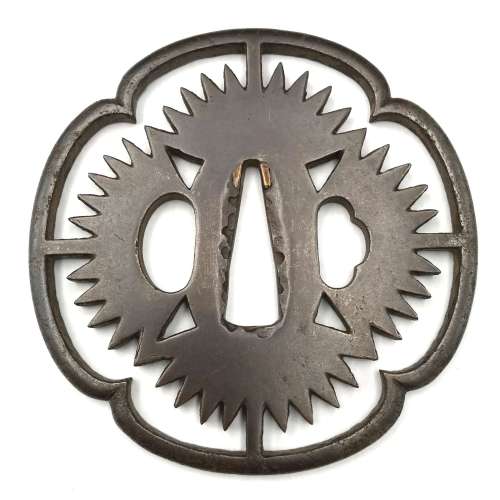 Iron tsuba of mokko form with slanting rays of light (shakoh) Christian motif (Jesuit's IHS symbol) in openwork (sukashi). Traditional description of this kind of design is called "tokei", or "clock gear". Owari school. Edo period.
Iron tsuba of mokko form with slanting rays of light (shakoh) Christian motif (Jesuit's IHS symbol) in openwork (sukashi). Traditional description of this kind of design is called "tokei", or "clock gear". Owari school. Edo period.Size: 83.4 x 83.1 x 4.4 mm
NTHK certified KANTEISHO ("Important Work"). In a custom wooden box. For information regarding shakoh tsuba see article 'Kirishitan Ikenie Tsuba by Fred Geyer at Kokusai Tosogu Kai; The 2nd International Convention & Exhibition, October 18-23, 2006, pp. 84-91. -
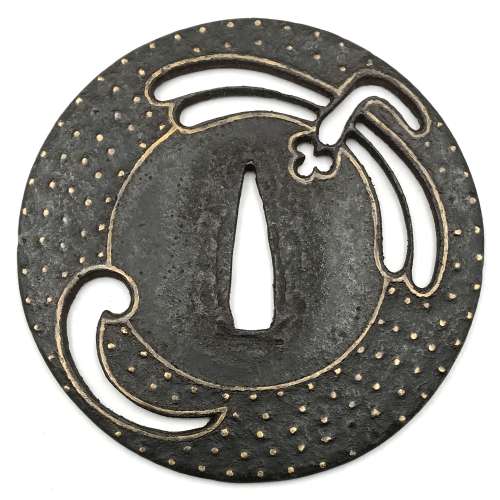 Iron tsuba of round form decorated with dragonfly (tombo) and comma (comma-like swirl, tomoe) in openwork (sukashi) outlined with brass wire. The plate decorated with 5 concentric circular rows of brass dots in ten-zōgan. Center of the plate outlined with the inlaid circular brass wire (sen-zōgan). Ōnin school. Unsigned. Mid Muromachi period, middle of the 15th century. Dimensions: Diameter: 89.5 mm, thickness: 3.1 mm. Notes regarding design: "According to various sources, the dragonfly (tombo) is emblematic of martial success, as various names for the insect are homophones for words meaning "victory". The dragonfly is also auspicious because references in the Kojiki and Nihongi link it in both name and shape to the old kingdom of Yamato." [Merrily Baird. Symbols of Japan. Thematic motifs in art and design. Rizzoli international publications, Inc., 2001, p. 108]. "The dragonfly (tonbo), was also called kachimushi in earlier times, and due to the auspicious literal meaning "victory bug" of the characters of this word it became a popular theme on sword fittings." [Iron tsuba. The works of the exhibition "Kurogane no hana", The Japanese Sword Museum, 2014, p. 13]. Helen C. Gunsaulus' description of the dragonfly emblem is as follows: "This motive, the dragon-fly (akitsu), is generally accepted as a symbol of the kingdom of Japan, and the origin of the idea is traced to the legend recounted in the Kojiki and Nihongo of the Emperor Jimmu's view of the island from mountain top. He is said to have thought the kingdom looked like a dragon-fly touching its tail with its mouth. From this it received its name Akitsu-shima... etc."
Iron tsuba of round form decorated with dragonfly (tombo) and comma (comma-like swirl, tomoe) in openwork (sukashi) outlined with brass wire. The plate decorated with 5 concentric circular rows of brass dots in ten-zōgan. Center of the plate outlined with the inlaid circular brass wire (sen-zōgan). Ōnin school. Unsigned. Mid Muromachi period, middle of the 15th century. Dimensions: Diameter: 89.5 mm, thickness: 3.1 mm. Notes regarding design: "According to various sources, the dragonfly (tombo) is emblematic of martial success, as various names for the insect are homophones for words meaning "victory". The dragonfly is also auspicious because references in the Kojiki and Nihongi link it in both name and shape to the old kingdom of Yamato." [Merrily Baird. Symbols of Japan. Thematic motifs in art and design. Rizzoli international publications, Inc., 2001, p. 108]. "The dragonfly (tonbo), was also called kachimushi in earlier times, and due to the auspicious literal meaning "victory bug" of the characters of this word it became a popular theme on sword fittings." [Iron tsuba. The works of the exhibition "Kurogane no hana", The Japanese Sword Museum, 2014, p. 13]. Helen C. Gunsaulus' description of the dragonfly emblem is as follows: "This motive, the dragon-fly (akitsu), is generally accepted as a symbol of the kingdom of Japan, and the origin of the idea is traced to the legend recounted in the Kojiki and Nihongo of the Emperor Jimmu's view of the island from mountain top. He is said to have thought the kingdom looked like a dragon-fly touching its tail with its mouth. From this it received its name Akitsu-shima... etc." -
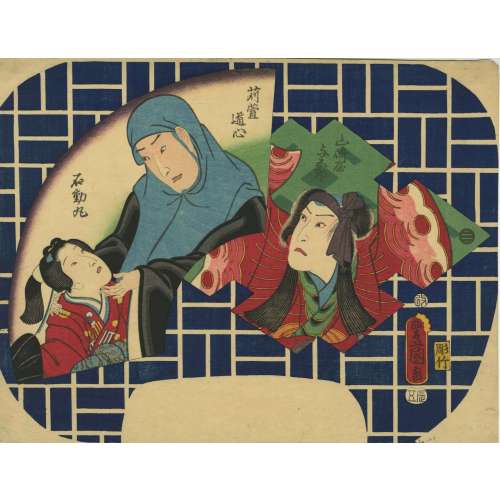 Utagawa Kunisada [歌川 国貞]; a.k.a. Utagawa Toyokuni III [三代歌川豊国] (Japanese, 1786 – 1865). Signed: Toyokuni ga [豊国 画] in a red toshidama cartouche. Publisher: Ibaya Senzaburō [伊場屋仙三郎] (Japanese, fl. 1815 – 1869). Block carver: Yokokawa Takejirō [横川竹二郎] (Japanese, fl. 1845 – 1863), seal: 彫竹 – Hori Take. Date seal and aratame censor seal: May of the Year of Dragon [辰五] (Tatsu-go) (5/1856) (Not in Marks).
Utagawa Kunisada [歌川 国貞]; a.k.a. Utagawa Toyokuni III [三代歌川豊国] (Japanese, 1786 – 1865). Signed: Toyokuni ga [豊国 画] in a red toshidama cartouche. Publisher: Ibaya Senzaburō [伊場屋仙三郎] (Japanese, fl. 1815 – 1869). Block carver: Yokokawa Takejirō [横川竹二郎] (Japanese, fl. 1845 – 1863), seal: 彫竹 – Hori Take. Date seal and aratame censor seal: May of the Year of Dragon [辰五] (Tatsu-go) (5/1856) (Not in Marks). Uncut fan print (uchiwa-e) depicting Onoe Kikugorō IV as Karukaya Dōshin parting from his son, Ishidomaru (played by Ichimura Uzaemon XIII), and Kawarasaki Gonjūrō I as Yamazakiya Yogoro in the kabuki play Karukaya Dōshin Tsukushi no Iezuto [苅萱桑門筑紫𨏍], written by Namiki Sōsuke [並木宗輔] (Japanese, 1695 – 1751) and performed at Ichimuraza [市村座] in 05/1856.
Media: Fan print [団扇絵] (Uchiwa-e); size: 235 x 305 mm.
Actors:
Onoe Kikugorō IV [四代目 尾上菊五郎] (Japanese, 1808 – 1860); other names: Onoe Baikō IV, Onoe Eizaburō III, Onoe Kikue, Nakamura Tatsuzō, Nakamura Kachō.
Onoe Kikugorō V [五代目尾上菊五郎] (Japanese, 1844 – 1903 other names: Onoe Baikō V, Ichimura Kakitsu IV, Ichimura Uzaemon XIII [十三代目市村羽左衛門], Ichimura Kurōemon.
Ichikawa Danjūrō IX [市川団十郎] (Japanese, 1838 – 1903); other names: Kawarasaki Sanshō, Kawarasaki Gonnosuke VII, Kawarasaki Gonjūrō I, Kawarasaki Chōjūrō III.
Plot: It was a popular belief at one time that jealous women had their hair transformed into writhing serpents and Kato Sayemon Shige-Uji, a daimyo of Tsukushi, a much-married man, suffered from the delusion that his wife was so affected. He fled to the mountains to escape her and led the life of a hermit under the name of Karukaya Doshin [苅萓道心]. One day, on Mount Kōya (高野山, Kōyasan) Karukaya meets a young man who was wandering in the mountains. Being questioned, the youth tells his name, Ishidomaru, and elicits the information that he is seeking his lost father. Karukaya then recognizes the boy as his own son, but firm in the resolve to remain lost to the world, he refrains from disclosing himself, and bids the youth return home.
Provenance: Paul F. Walter (American, 1935 – 2017).
Ref.:
Uncut fan print (uchiwa-e) depicting Onoe Kikugorō IV as Karukaya Dōshin parting from his son, Ishidomaru (played by Ichimura Uzaemon XIII), and Kawarasaki Gonjūrō I as Yamazakiya Yogoro in the kabuki play Karukaya Dōshin Tsukushi no Iezuto [苅萱桑門筑紫𨏍], written by Namiki Sōsuke [並木宗輔] (Japanese, 1695 – 1751) and performed at Ichimuraza [市村座] in 05/1856.
Media: Fan print [団扇絵] (Uchiwa-e); size: 235 x 305 mm.
Actors:
Onoe Kikugorō IV [四代目 尾上菊五郎] (Japanese, 1808 – 1860); other names: Onoe Baikō IV, Onoe Eizaburō III, Onoe Kikue, Nakamura Tatsuzō, Nakamura Kachō.
Onoe Kikugorō V [五代目尾上菊五郎] (Japanese, 1844 – 1903 other names: Onoe Baikō V, Ichimura Kakitsu IV, Ichimura Uzaemon XIII [十三代目市村羽左衛門], Ichimura Kurōemon.
Ichikawa Danjūrō IX [市川団十郎] (Japanese, 1838 – 1903); other names: Kawarasaki Sanshō, Kawarasaki Gonnosuke VII, Kawarasaki Gonjūrō I, Kawarasaki Chōjūrō III.
Plot: It was a popular belief at one time that jealous women had their hair transformed into writhing serpents and Kato Sayemon Shige-Uji, a daimyo of Tsukushi, a much-married man, suffered from the delusion that his wife was so affected. He fled to the mountains to escape her and led the life of a hermit under the name of Karukaya Doshin [苅萓道心]. One day, on Mount Kōya (高野山, Kōyasan) Karukaya meets a young man who was wandering in the mountains. Being questioned, the youth tells his name, Ishidomaru, and elicits the information that he is seeking his lost father. Karukaya then recognizes the boy as his own son, but firm in the resolve to remain lost to the world, he refrains from disclosing himself, and bids the youth return home.
Provenance: Paul F. Walter (American, 1935 – 2017).
Ref.:
- [LIB-2110.2019] Samuel L. Leiter. Historical Dictionary of Japanese Traditional Theatre (Historical Dictionaries of Literature and the Arts). / 2nd edition. – Lanham: Rowman & Littlefield, 2014; pp. 379-380.
- [LIB-2206.2019] Basil Stewart. Subjects portrayed in Japanese colour-prints. — London: Kegan Paul, Trench, Trubner & Co. Ltd., 1922.
-
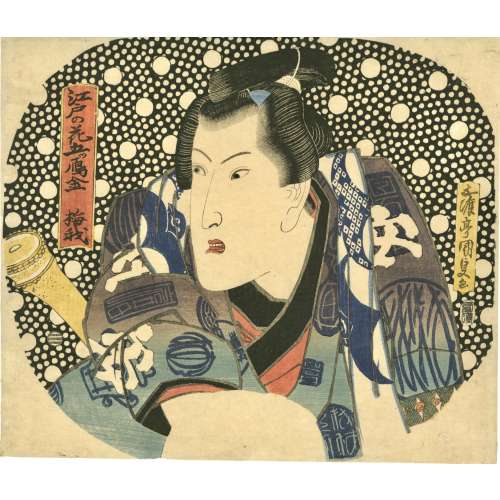 Artist: Utagawa Kunisada, a.k.a. Toyokuni III (Japanese, 1786 – 1865) [歌川 国貞]. Publisher: Ibaya Senzaburō [伊場屋仙三郎] (Japanese, fl. C. 1845 – 1847). Date aratame seal: Bunsei 12 (1829). Signed: Gototei Kunisada ga [五渡亭国貞画]. Media: Fan print (uchiwa-e), 272 x 235 mm. Actor: Iwai Hanshirō VI (Japanese, 1799 – 1836); other names: Iwai Hanshirō VI, Iwai Kumesaburō II, Iwai Hisajirō I, Baiga [梅我] (poetry name), Shūka (poetry name). The background is Arare-ko-mon [霰小紋] hail pattern. Kabuki actor Iwai Kumesaburō II in the role of An no Heibei [安の平兵衛] in the drama Otokodate Itsutsu Karigane [男作五雁金] (Play, 7 acts. Produced 1742/09). From Lyon collection: The real An no Heibei (ca. 1672-1702): "In a gang with Kaitate no Kichiemon, Hote no Ichiemon, Mippiki Jihei and others as of the Seventh Month of 1697. Attacked people with a sword on the sixth day, Seventh Month, 1699, which he then secreted with Kichiemon. On the evening of the sixth day, Sixth Month, 1701, stabbed Kibei, an employee of Kawachiya Gohei of the residential quarter Kyuhoji, in the side with a dagger. A subsequent police investigation resulted in Heibei's arrest the following day. Beheaded at the execution grounds located at Sennichi Mae on the twenty-sixth day of the Eighth Month, 1702." Note: According to Horst Graebner, the actor's name below the series title in the cartouche is Baiga (梅我), the poetry name of Iwai Kumesaburō II. On the other prints in this series, the actors are also named on the other prints with their poetry names. In the red cartouche at the top left is the series title "Edo no hana – itsutsu Karigane" (江戸の花 五雁金), to be translated as "Flowers of Edo - the five Karigane blood-brothers" (or "the five Karigane gang members"). "Since there was no performance with the Karigane brothers from 1829, these must be mitate prints", states Mr Graebner.
Artist: Utagawa Kunisada, a.k.a. Toyokuni III (Japanese, 1786 – 1865) [歌川 国貞]. Publisher: Ibaya Senzaburō [伊場屋仙三郎] (Japanese, fl. C. 1845 – 1847). Date aratame seal: Bunsei 12 (1829). Signed: Gototei Kunisada ga [五渡亭国貞画]. Media: Fan print (uchiwa-e), 272 x 235 mm. Actor: Iwai Hanshirō VI (Japanese, 1799 – 1836); other names: Iwai Hanshirō VI, Iwai Kumesaburō II, Iwai Hisajirō I, Baiga [梅我] (poetry name), Shūka (poetry name). The background is Arare-ko-mon [霰小紋] hail pattern. Kabuki actor Iwai Kumesaburō II in the role of An no Heibei [安の平兵衛] in the drama Otokodate Itsutsu Karigane [男作五雁金] (Play, 7 acts. Produced 1742/09). From Lyon collection: The real An no Heibei (ca. 1672-1702): "In a gang with Kaitate no Kichiemon, Hote no Ichiemon, Mippiki Jihei and others as of the Seventh Month of 1697. Attacked people with a sword on the sixth day, Seventh Month, 1699, which he then secreted with Kichiemon. On the evening of the sixth day, Sixth Month, 1701, stabbed Kibei, an employee of Kawachiya Gohei of the residential quarter Kyuhoji, in the side with a dagger. A subsequent police investigation resulted in Heibei's arrest the following day. Beheaded at the execution grounds located at Sennichi Mae on the twenty-sixth day of the Eighth Month, 1702." Note: According to Horst Graebner, the actor's name below the series title in the cartouche is Baiga (梅我), the poetry name of Iwai Kumesaburō II. On the other prints in this series, the actors are also named on the other prints with their poetry names. In the red cartouche at the top left is the series title "Edo no hana – itsutsu Karigane" (江戸の花 五雁金), to be translated as "Flowers of Edo - the five Karigane blood-brothers" (or "the five Karigane gang members"). "Since there was no performance with the Karigane brothers from 1829, these must be mitate prints", states Mr Graebner. -
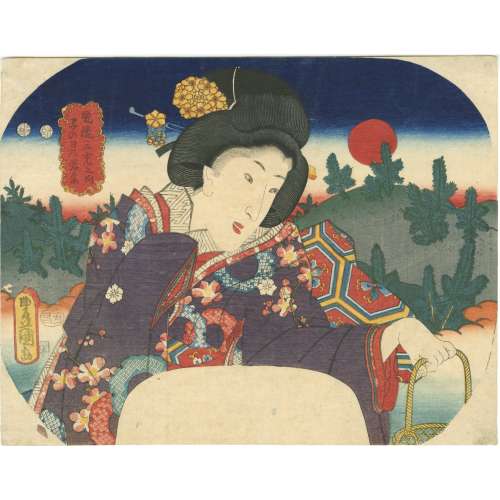 An uncut fan print shows a young woman holding a basket on a landscape background with hills and pines under a rising sun. Haruo Shirane: "Under the luni-solar calendar, the New Year coincided with the beginning of spring, making it the most important observance of the year for the aristocracy. In the Heian period, New Year ceremonies extended from New Year’s Day (Ganjitsu) to the Day of the Rat (Nenohi), which usually fell on the seventh day of the First Month, when courtiers went out to the fields (no), pulled up small pines, and gathered new herbs (wakana) as a prayer for long life. This ritual gradually spread to the provinces and to commoners, eventually resulting in the New Year practice of the gate pine (kadomatsu), in which a pair of small pines was placed at the gate of a house. A popular Heian-period painting topic representing the First Month was “prayers on the Day of the Rat” (Nenohi no asobi), which depicted the auspicious scene of pulling up small pines in a spring field. Both young herbs and gathering young herbs, particularly at Kasuga Field, became major poetic topics for the First Month, appearing in both the spring and celebration (ga) books of the Kokinshū (Collection of Japanese Poems Old and New, ca. 905). By the Kamakura period, the observance of the Day of the Rat had been abandoned at the imperial court, but the custom of gathering and eating young greens continued as the annual ceremony known as the Seven Grasses (Nanakusa). Note: The Heian-period ritual of pulling up the roots of small pines (komatsu ) on the first Day of the Rat derives from the homonyms ne (rat) and ne (root). Pulling up roots was auspicious, since it implied lengthening the year. The rising sun (hinode) was considered an auspicious sight, particularly at the beginning of the year". [Haruo Shirane, Japan and the Culture of the Four Seasons. Nature, Literature, and the Arts. — Columbia University, NY, 2012]. Title: Gathering of the young herbs on the Day of the Rat [子の日乃若菜] (Nenohi no wakana). Series: Three elegant sources of light [風流三光の内] (fūryū sankō no uchi); meaning the sun, the moon and the stars). Artist: Utagawa Kunisada [歌川 国貞]; a.k.a. Utagawa Toyokuni III [三代歌川豊国] (Japanese, 1786 – 1865). Signed: Toyokuni ga [豊国 画] in a yellow toshidama cartouche. Publisher’s seal: Izuzen (Marks: seal 06-029 | U103b) Date and double nanushi censor seals: Mera and Watanabe, Kaei 6 (1853). A similar theme can be found in Kunisadai's triptych published in about 1844 (HARA SHOBO):
An uncut fan print shows a young woman holding a basket on a landscape background with hills and pines under a rising sun. Haruo Shirane: "Under the luni-solar calendar, the New Year coincided with the beginning of spring, making it the most important observance of the year for the aristocracy. In the Heian period, New Year ceremonies extended from New Year’s Day (Ganjitsu) to the Day of the Rat (Nenohi), which usually fell on the seventh day of the First Month, when courtiers went out to the fields (no), pulled up small pines, and gathered new herbs (wakana) as a prayer for long life. This ritual gradually spread to the provinces and to commoners, eventually resulting in the New Year practice of the gate pine (kadomatsu), in which a pair of small pines was placed at the gate of a house. A popular Heian-period painting topic representing the First Month was “prayers on the Day of the Rat” (Nenohi no asobi), which depicted the auspicious scene of pulling up small pines in a spring field. Both young herbs and gathering young herbs, particularly at Kasuga Field, became major poetic topics for the First Month, appearing in both the spring and celebration (ga) books of the Kokinshū (Collection of Japanese Poems Old and New, ca. 905). By the Kamakura period, the observance of the Day of the Rat had been abandoned at the imperial court, but the custom of gathering and eating young greens continued as the annual ceremony known as the Seven Grasses (Nanakusa). Note: The Heian-period ritual of pulling up the roots of small pines (komatsu ) on the first Day of the Rat derives from the homonyms ne (rat) and ne (root). Pulling up roots was auspicious, since it implied lengthening the year. The rising sun (hinode) was considered an auspicious sight, particularly at the beginning of the year". [Haruo Shirane, Japan and the Culture of the Four Seasons. Nature, Literature, and the Arts. — Columbia University, NY, 2012]. Title: Gathering of the young herbs on the Day of the Rat [子の日乃若菜] (Nenohi no wakana). Series: Three elegant sources of light [風流三光の内] (fūryū sankō no uchi); meaning the sun, the moon and the stars). Artist: Utagawa Kunisada [歌川 国貞]; a.k.a. Utagawa Toyokuni III [三代歌川豊国] (Japanese, 1786 – 1865). Signed: Toyokuni ga [豊国 画] in a yellow toshidama cartouche. Publisher’s seal: Izuzen (Marks: seal 06-029 | U103b) Date and double nanushi censor seals: Mera and Watanabe, Kaei 6 (1853). A similar theme can be found in Kunisadai's triptych published in about 1844 (HARA SHOBO):
豊国三代「豊歳子日若菜摘ノ図」
-
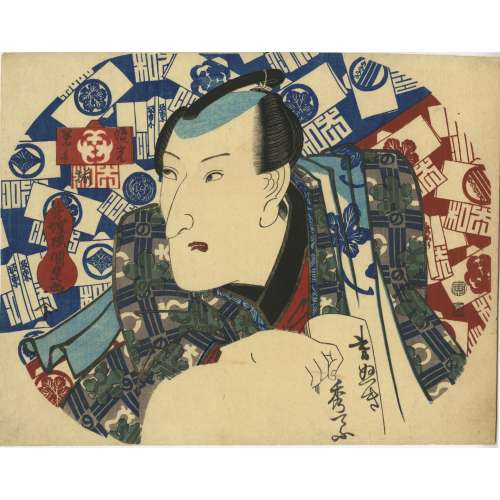 Artist: Utagawa Kunisada [歌川 国貞] a.k.a. Utagawa Toyokuni III [三代歌川豊国] (Japanese, 1786 – 1865). Signed: Kochoro Kuisada ga [香蝶楼国貞画] in a red double-gourd cartouche Publisher: Enshūya Matabei [遠州屋又兵衛] (Japanese, fl. c. 1768 – 1881). Series: Fashionable Youths [流行若手揃] (Ryuko Wakate Zoroi). Actor: Bandō Minosuke II [坂東蓑助] (Japanese, 1802 – 1863); other names: Morita Kan'ya XI, Bandô Mitsugorō IV. Date-kiwame seals: Bunsei 13 / Tenpō 1 (1830). One more print from the same series (See Waseda 201-2125); not in this collection: Segawa Kikunojō V [瀬川菊之丞] (Japanese, 1802 – 1832); other names: Segawa Tamon I.
Artist: Utagawa Kunisada [歌川 国貞] a.k.a. Utagawa Toyokuni III [三代歌川豊国] (Japanese, 1786 – 1865). Signed: Kochoro Kuisada ga [香蝶楼国貞画] in a red double-gourd cartouche Publisher: Enshūya Matabei [遠州屋又兵衛] (Japanese, fl. c. 1768 – 1881). Series: Fashionable Youths [流行若手揃] (Ryuko Wakate Zoroi). Actor: Bandō Minosuke II [坂東蓑助] (Japanese, 1802 – 1863); other names: Morita Kan'ya XI, Bandô Mitsugorō IV. Date-kiwame seals: Bunsei 13 / Tenpō 1 (1830). One more print from the same series (See Waseda 201-2125); not in this collection: Segawa Kikunojō V [瀬川菊之丞] (Japanese, 1802 – 1832); other names: Segawa Tamon I.
-
 Iron tsuba of the round form (丸型, maru–gata), decorated with brass flat inlay (平象嵌, hira-zōgan) of bellflowers, leaves, and vines on both sides, inlaid brass is carved in low relief; wide rim (dote-mimi) also inlaid; the plate is pierced with hitsu-ana (probably original); nakago-ana plugged with copper sekigane. Dimensions: Height: 84.1 mm; Width: 82.0 mm; Thickness (centre): 2.8 mm; mimi is 11.8 mm wide and 4.7 mm thick. Produced at the end of the 16th century, in the Momoyama period (1674–1703).
Iron tsuba of the round form (丸型, maru–gata), decorated with brass flat inlay (平象嵌, hira-zōgan) of bellflowers, leaves, and vines on both sides, inlaid brass is carved in low relief; wide rim (dote-mimi) also inlaid; the plate is pierced with hitsu-ana (probably original); nakago-ana plugged with copper sekigane. Dimensions: Height: 84.1 mm; Width: 82.0 mm; Thickness (centre): 2.8 mm; mimi is 11.8 mm wide and 4.7 mm thick. Produced at the end of the 16th century, in the Momoyama period (1674–1703).


